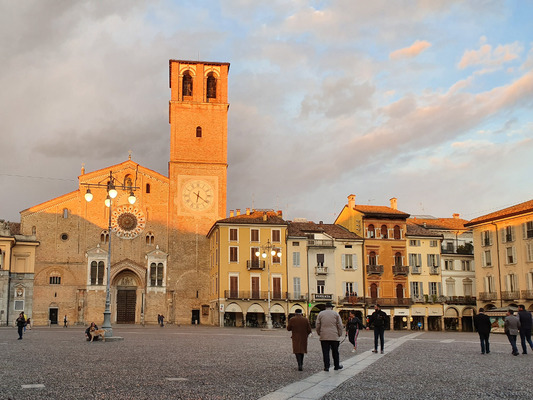
The origin of Lodi is linked to the destruction of the Roman Laus Pompieia, which took place in 1111 and 1158 at the hands of the Milanese.
The new town, situated on top of Eghezzone Hill and on the right bank of the Adda River, was founded on 3 August 1158 AD by Federick I of Swabia, kown as Barbarossa.
The heart of the historic centre consists of the beautiful square-shaped Piazza della Vittoria, overlooked by important monuments dating from the Middle Ages on.
Duomo di Lodi
The facade, in brickwork, is asymmetrical and is in a typical Romanesque style, with the exception of the large Gothic entrance portico supported by small columns with lion sculptures at the base. Other features include the large central rose window and a niche housing the statue of Federico Barbarossa, that is the founder of Lodi.
The interior has a nave and two aisles separated by cylindrical pilasters in brickwork. Artworks include a polyptych by Callisto Piazza depicting the Massacre of the Innocents, another polyptych by Albertino Piazza with the Virgin in Heave. Finally, the large apse is decorated by a mosaic executed by Aligi Sassu.
Tempio Civico della Beata Vergine Incoronata
The Tempio Civico della Beata Vergine Incoronata is a church in Lodi, Lombardy, Italy. It is considered one of the masterworks of the Lombard Renaissance art.The church was designed in 1488 by Giovanni Battagio (a pupil of Bramante), continued by Gian Giacomo Dolcebuono and finished by Giovanni Antonio Amadeo, and built at expenses of the Lodi commune, whence the denomination "Civico" ("Municipal"), on the site previously occupied by a brothel.
The church is located in a very narrow street near the Piazza della Vittoria, Lodi's most famous square. It has an octagonal plan, surmounted by a dome with the same shape with a lantern at the top. Externally, running around the octagonal tambour is a balaustrade with small columns and pinnacles. The bell tower was built in 1503, while the façade was completed only in 1879 by Alfonsino Truzzi.
The interior is characterized by sumptuous decorations in gold; in the upper sector is an arcaded matronaeum with blue and golden columns. It also houses a large gallery of artworks from the late 15th to the early 19th century, executed by the major artists working in Lodi. There are four panels by Bergognone, including an Annunciation and a Presentation at the Temple, reproducing the church's interior of the time. The Berinzaghi Polyptych and an Incoronation of the Virgin are by brothers Martino and Albertino Piazza.
Provincial Astronomical Observatory.
The observatory is equipped with a rotating dome for observing the skies, a videoconference room and two dormitories for school groups.
Managed by the Messier 42 Astrophiles Group, the observatory regularly holds initiatives to popularize astronomy and science, and is heavily involved in research, collaborating with astrophysicists throughout Europe.
Parco Adda Sud.
The Adda Sud is a regional, fluvial and agricultural park and includes various towns of Lodi and Cremona Provinces. As well as riverside woods, the protected area also encompasses marshy areas consisting of oxbows that river Adda has formed over time as it changed course. The vegetation landscape is characterized by wooded areas, wetlands and river beaches. The wetlands are remarkable from a naturalistic point of view. Fauna consists mainly of birds, with no less than three heronries in the park. Fish fauna includes river lamprays, while mammals of interest are skunks in the better preserved wetlands and dormice in the more extensive woods.